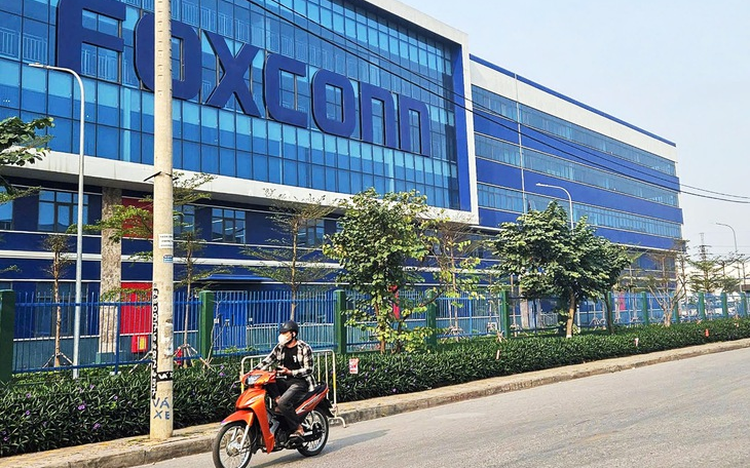
The factory of Foxconn Group, a global partner of Apple, located in an industrial park in Bac Ninh Province, northern Vietnam. Photo: Ha Quan / Tuoi Tre
In the first half of 2025, foreign direct investment (FDI) into Vietnam surpassed US$21.5 billion, the highest since 2009.
Disbursed capital also rose more than eight percent to over $11.7 billion.
Vietnam – a trusted partner
Earlier this week, Vietnamese Prime Minister Pham Minh Chinh met with leaders of Makara Capital, one of Singapore’s major investment and asset management groups.
At the meeting, the Makara Capital executives expressed interest in investing in sectors such as biopharmaceuticals, energy, infrastructure, and finance.
The group also showed interest in participating in Vietnam's banking sector restructuring and in developing international financial centers, with a potential investment mobilization capacity of $5-7 billion.
Earlier, during an official visit to Malaysia, Prime Minister Chinh held talks with leaders of real estate firm Gamuda Land. The group proposed pouring an additional $1.1 billion into the Yen So Park project in Hanoi.
This investment helped position Hanoi as the leading FDI destination in the country during the first half of the year.
Dato' Chow Chee Wah, chairman of Gamuda Land, said that beyond their current total investment, already exceeding $5 billion, the company aims to inject billions of U.S. dollars into green infrastructure and urban projects in Vietnam.
The firm also proposed studying metro lines connecting Ho Chi Minh City to the under-construction Long Thanh International Airport in Dong Nai Province and other urban rail systems.
Kunihiko Hirabayashi, secretary-general of the ASEAN-Japan Center, told Tuoi Tre (Youth) newspaper that Vietnam has emerged as a core platform in ASEAN’s supply chain network. Rather than serving as a mere link, Vietnam is now actively reinforcing global value chains.
He believes Vietnam will continue to lead in pioneering green supply chains, fostering innovation, and driving sustainable regional growth in collaboration with other countries.
According to him, Vietnam has a range of strategic advantages for attracting regional investment: a solid foundation with a young workforce, competitive costs, and a prime location at the heart of ASEAN.
These advantages have transformed Vietnam into an ideal hub for manufacturing and logistics and have enhanced the country’s participation in free trade agreements.
Vietnam’s strong reputation also plays a crucial role.
Hirabayashi highlighted that Japan currently has over 5,500 investment projects in Vietnam.
More than half of the Japanese firms surveyed plan to expand their operations in the country, the highest rate in ASEAN.
This confidence stems from a stable policy environment and complementary industrial structures between Japan and Vietnam.
“Vietnam’s industries often fill gaps rather than compete directly, creating mutually beneficial partnerships that enhance trade connectivity across ASEAN,” he explained.
A strategic gateway
FDI inflows are expected to continue rising as investors view Vietnam not only as a 100-million-strong domestic market but also as a strategic gateway to Southeast Asia and the broader Asian region, where consumer demand is increasing rapidly.
According to a mid-2025 survey by the American Chamber of Commerce in Vietnam, around 18 percent of participating companies reported that their business performance in the first half of the year exceeded expectations, especially in logistics, large-scale manufacturing, and F&B sectors.
About 37 percent of the firms rated the business environment in Vietnam as “relatively positive.”
Overall, the American business community observed that the first half reflected a resilient and adaptive business environment amid ongoing structural shifts.
Despite maintaining a cautious outlook, businesses continued to invest, hire, and innovate.
Singapore remained the leading source of FDI in Vietnam, followed by South Korea, China, and Japan.
Seck Yee Chung, vice-chairman of the Singapore Chamber of Commerce in Vietnam, noted that Singaporean businesses are generally optimistic and resilient.
He identified high-growth sectors attracting attention, such as technology, digital transformation, manufacturing, logistics, and healthcare—driven by increasing demand for medical services in both Vietnam and Southeast Asia.
Boosting domestic production capacity
According to the World Bank, Vietnam is expected to benefit the most from the Regional Comprehensive Economic Partnership, a free trade agreement that encompasses 15 Asia-Pacific economies, with potential export growth of about 11 percent and national income rising nearly five percent if fully leveraging the agreement.
However, to capitalize on free trade pact opportunities, Hirabayashi emphasized the need for Vietnam to enhance domestic production standards and capacity, especially by enabling small and medium enterprises (SMEs) to meet quality and origin requirements.
Simplifying customs procedures and rules of origin will be critical in helping SMEs integrate effectively into regional supply chains.


Max: 1500 characters
There are no comments yet. Be the first to comment.